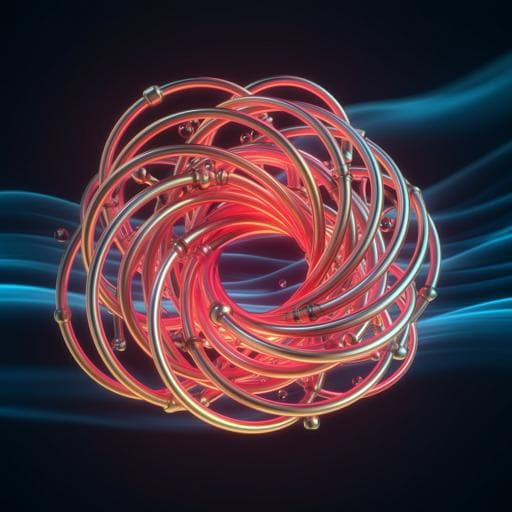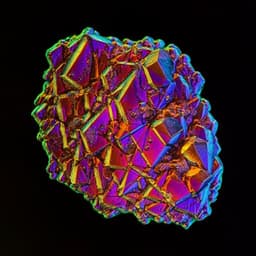
Engineering and Technology
Machine learning-assisted discovery of flow reactor designs
T. Savage, N. Basha, et al.
Discover how a team of researchers, including Tom Savage, Nausheen Basha, and Omar Matar, employs machine learning and additive manufacturing to revolutionize chemical reactor design. Their innovative approach led to a remarkable 60% improvement in plug flow performance, showcasing the synergy between advanced manufacturing and augmented intelligence.
~3 min • Beginner • English
Introduction
The study addresses how to design coiled-tube flow reactors that achieve enhanced plug-flow behavior at low Reynolds numbers without relying on oscillatory forcing. The context is the rapid expansion of viable reactor geometries enabled by additive manufacturing and the emergence of data-driven, multi-fidelity Bayesian optimization for exploring large simulation-based design spaces. The purpose is to combine high-dimensional geometric parameterizations, CFD simulations, and multi-fidelity Bayesian optimization to discover reactor features that induce and sustain Dean vortices under steady flow at Re = 50, thereby improving radial mixing while controlling axial dispersion. The importance lies in potentially surpassing conventional coiled-tube performance, enabling compact, energy- and resource-efficient chemical processing and providing a generalizable workflow for machine learning-assisted reactor discovery.
Literature Review
Coiled-tube reactors are widely used due to favorable mixing and heat-transfer characteristics across flow chemistry, bioprocessing, and kinetic studies. Prior work demonstrates mesoscale coiled reactors can combine microreactor transport performance with higher throughput. Dean vortices, arising from centrifugal effects in curved pipes, enhance radial mixing but typically require higher Re and Dean numbers under steady flow. At low Re (≤50), previous improvements in plug-flow performance relied on superimposed pulsed-flow conditions to induce Dean vortices. There is evidence for an approximately linear relationship between number of coil turns and tanks-in-series (plug-flow) performance. On the optimization side, multi-fidelity Bayesian optimization has proven effective for large-scale, expensive simulations, enabling the use of cheaper, biased fidelities to accelerate convergence when gradients are unavailable or a global search is preferred. Prior reactor optimization studies validated multi-fidelity CFD fidelity choices and established relationships between mesh fidelity and RTDs. Designs such as wavering coiled flow inverters also illustrate geometry-driven mixing enhancement through path inversions, though distinct from the features discovered here.
Methodology
Overview: The authors develop an augmented-intelligence workflow coupling high-dimensional geometric parameterizations of coiled-tube reactors, multi-fidelity CFD simulations in OpenFOAM, and multi-fidelity Bayesian optimization (DARTS) to maximize plug-flow performance while penalizing non-ideal RTD shapes. Designs discovered computationally are 3D-printed and validated experimentally.
Geometry parameterizations:
- Two primary parameterizations were used: (1) cross-section variation along the reactor length; (2) coil path variation in 3D space. A joint strategy fixed the optimal path and then varied the cross-section.
- Nominal coil: pitch p = 10.4 mm, coil radius C = 12.5 mm, two coil rotations (overall length 4C) for simulations, based on prior work showing low pitch and large coil radius are favorable.
Cross-section parameterization (polar Gaussian processes):
- For each tubular cross-section, nθ inducing points are equally spaced in polar angle θ; their radial coordinates rin,i are decision variables bounded between 2–4 mm.
- A polar GP interpolates between inducing points using a polar kernel to ensure correct angular periodicity and smooth closed curves. The polar covariance function is k(θ,θ′) = (1 + d(θ,θ′)/τ)^{-1}, τ ≥ 4, with angular distance d(θ,θ′) = ((θ − θ′ + π) mod 2π) − π.
- Along the reactor length, nr inducing cross-sections (indices j) are defined and interpolated by quadratic interpolation in cylindrical coordinates between the respective polar GP posteriors. Two terminal sections with constant radius ensure fixture compatibility.
- Cross-sections are placed perpendicular to local flow direction along the path. Mesh fidelity can be varied independently in axial and radial directions.
- Example hyperparameters shown: nr = 6, nθ = 6.
Coil path parameterization:
- Baseline helical path in cylindrical coordinates (ρ0, φ0, z0) is perturbed by inducing point deviations (Δρj, Δzj) at nj locations (nj = 6 in both radial and axial directions; none in φ to avoid self-intersection).
- Parameter bounds ensure feasible, non-intersecting coils: Δz ∈ [−1, 1] mm; Δρ ∈ [−3.5, 3.5] mm.
- Circles of constant cross-section are placed perpendicular to flow along the deviated path.
CFD simulations (OpenFOAM):
- Operating condition: steady-state base flow with Re = 50. RTDs computed via impulse tracer injection in water.
- Solvers: transient pimpleFOAM for unsteady momentum; scalarTransportFoam for convection–diffusion with low diffusion coefficient. Outlet concentration integral recorded over time; termination when tracer drops below threshold.
- Mesh fidelity parameters: independent axial and radial subdivisions controlling computational cost and accuracy; fidelities treated as continuous during modeling, rounded at evaluation. Prior work validated fidelity choices.
Optimization (DARTS multi-fidelity Bayesian optimization):
- Objective: composite function to maximize plug-flow performance while penalizing non-ideal RTDs. The RTD is fit to a tanks-in-series model to estimate N (higher N → stronger plug flow). A penalty term accounts for asymmetry, long tails, or bimodality by weighting the mean-squared error between observed RTD and best-fit tanks-in-series curve. Weight α ≈ 100 balances contributions.
- Gaussian processes model both objective and simulation cost as functions of geometry and fidelities. A cost-adjusted acquisition function selects the next geometry x and fidelity z to balance exploitation, exploration (β = 1.5), and cost; stopping governed by ρ0 = 2. Time budgets scaled with dimensionality (≈72–168 h per parameterization). All runs used 64 CPUs, one RTX6000 GPU (for GP training/evaluation), and 64 GB RAM.
- Dimensionality reduction and convergence diagnostics: t-SNE on design parameters to visualize trajectories in parameter space; analysis of GP kernel length scales over iterations to assess learning of local structure; parameter variability defined as normalized inverse GP length scales to identify influential geometric features.
Experimental validation and fabrication:
- Selected designs were exported from meshes as STL, then encased in a bounding cylinder for printability. Linear inlet/outlet adapted to OD 8/10 mm tube fittings; void reduction between coils minimized resin use.
- Printed on FormLabs Form3+ with Clear V4 resin; post-processing: 20 min IPA wash, 24 h dry, 30 min post-cure at 60°C.
- RTD experiments: deionized water carrier; 0.1 M KCl impulse tracer; conductivity measured at outlet. Three TriContinent C3000 syringe pumps controlled flows via PTFE tubing and custom Swagelok connections. Three repeats per reactor.
- Mixing test reaction: Villermaux–Dushman system with specified reagent concentrations; absorbance of I3− at 353 nm measured at outlet using a 10 mm cuvette, three repeats per reactor.
Design labels:
- Design 1: conventional control coil.
- Design 2: optimized cross-section variation along length.
- Design 3: optimized coil path variation.
- Design 4: joint parameterization (path fixed to Design 3, cross-section varied). For extrapolated, longer coils used in experiments: R1 (nominal), R2 (variable cross-section), R3 (variable cross-section + path).
Key Findings
- Geometry–flow linkage: Periodic expansions/contractions of cross-section and distinct pinches redistribute streamwise velocity and strengthen pressure gradients, inducing earlier, fully developed Dean vortices at Re = 50 under steady flow. This enhances radial mixing and reduces axial dispersion via alternating acceleration/deceleration across the cross-section.
- Optimal feature set: (i) cross-section expansion then contraction approximately every half-turn; (ii) distinct pinches at locations of maximum cross-sectional area; (iii) coil path changes including local constrictions (reduced radius) and pitch modulation. Design 4 exhibits these features and shows early full Dean vortex formation compared to the standard coil.
- RTD and plug-flow performance (experiments at Re = 50):
• R1 (standard coil): equivalent tanks-in-series N_R1 = 39.27 ± 17.09 (95% CI), skewed RTD.
• R2 (variable cross-section): N_R2 = 61.0 ± 11.85 (95% CI), symmetric RTD; +55% vs R1.
• R3 (variable cross-section + path): N_R3 = 63.45 ± 16.46 (95% CI), symmetric RTD; +62% vs R1.
These gains match the ~60% plug-flow improvement predicted by simulations.
- Mixing-sensitive reaction (Villermaux–Dushman, absorbance at 353 nm):
• R1: average A = 0.273 (experiments: 0.267, 0.276, 0.275).
• R2: average A = 0.293 (0.292, 0.288, 0.300).
• R3: average A = 0.325 (0.326, 0.324, 0.325).
Higher absorbance indicates greater conversion under mixing-limited conditions, confirming enhanced mixing in optimized reactors.
- Pressure drop: CFD indicates a 29.3% higher pressure drop per single coil turn for the optimized geometry versus standard; difference increases with coil length.
- Optimization behavior: Cross-section parameterization showed better convergence than path or joint parameterizations. GP length scales decreased over iterations, reflecting learned nonlinearity; t-SNE revealed a coherent trajectory in parameter space with multi-fidelity evaluations along the path. Parameter variability analysis highlighted pinches as the most influential features on objective variability.
Discussion
The findings demonstrate that an augmented-intelligence workflow can discover geometric features that elicit fully developed Dean vortices at low Reynolds numbers under steady flow, enabling substantial improvements in plug-flow performance without oscillatory forcing. The combined cross-section and path features redistribute streamwise velocities and strengthen secondary flows, narrowing RTDs and improving mixing-performance proxies. Although global optimality is not guaranteed, the multi-fidelity Bayesian optimization approach explores a broader region than local gradient-based methods and yields interpretable design features that can be transferred to practical geometries. The experimental validation with RTDs and the Villermaux–Dushman reaction confirms that optimizing RTD characteristics is an effective proxy for enhancing reactor mixing performance. The observed increase in pressure drop suggests a trade-off between mixing/plug-flow performance and hydraulic losses, motivating future multi-objective formulations. Sharing parameterizations and code as benchmark problems encourages further research on high-dimensional, expensive black-box optimization in reactor design.
Conclusion
This work presents a machine learning-assisted design framework that integrates high-dimensional geometric parameterizations, multi-fidelity CFD simulations, and cost-aware Bayesian optimization to discover coiled-tube reactors with substantially improved plug-flow performance at low Re. Key design concepts—periodic cross-section expansion/contraction, strategically placed pinches, and tailored coil path variations—were identified, fabricated via 3D printing, and experimentally validated, yielding ~55–62% increases in equivalent tanks-in-series and higher conversion in a mixing-sensitive reaction compared with a nominal coil. The approach illustrates how augmented intelligence and additive manufacturing can produce interpretable, high-performance reactor designs and provides open benchmarks to catalyze advances in optimization methodology. Future work should incorporate multi-objective optimization to balance pressure drop and performance, extend comparisons across a broader set of coil designs, and apply the workflow to reactive and multiphase systems.
Limitations
- Optimality: The global optimum is not guaranteed; solutions depend on the chosen parameterizations, priors, and search budget.
- Trade-offs not optimized: Increased pressure drop (≈29.3% per coil turn) was observed for optimized designs; hydraulic losses were not included in the objective and power consumption was not measured experimentally.
- Parameterization artifacts: The optimized coil path exhibited unintended downward pitch near the outlet, highlighting sensitivity to parameterization choices and constraints.
- Fidelity and modeling assumptions: Multi-fidelity surrogates assume smooth dependence on axial/radial mesh fidelities; RTD fitting via tanks-in-series can be a poor approximation for non-ideal, complex RTDs, necessitating the composite penalty term.
- Scale and scope: Simulations initially used two coil rotations for tractability and then extrapolated features to longer experimental reactors; only Re = 50 steady flows were studied. Broader operating ranges, multiphase flows, and chemistries were not explored within the main study.
Related Publications
Explore these studies to deepen your understanding of the subject.







